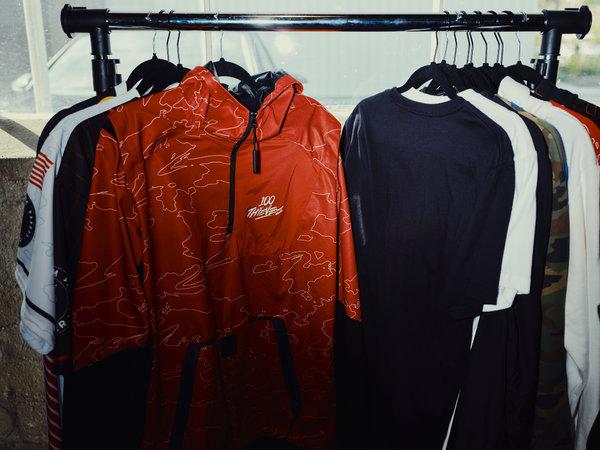Matt Haag wasn’t exactly dressing to impress during his teenage years on the competitive Call of Duty circuit. The 26-year-old recalled, sheepishly, the basketball shorts and Payless kicks he wore on flights to tournaments around the country back in 2008. All of his gamer friends and teammates looked the same way: schlubby.
But in the last decade, something changed. “I just wanted to look better,” Mr. Haag said. “I needed a girlfriend. I was trying to be cooler. It was as simple as that.”
Today, Mr. Haag, known as Nadeshot, is the chief executive of 100 Thieves, an esports organization that makes apparel for competitive gamers and their fans. He has more than 1 million followers on Instagram and routinely uses the platform to model the latest in 100 Thieves merchandise: splashy graphic tees, athleisure hoodies and starchy camo pullovers, which pair nicely with Mr. Haag’s vast collection of Creamsicle-colored sneakers.
The price point for 100 Thieves merchandise compares to many midpriced athleisure brands; shoppers can expect to pay $85 for a hoodie. Other gamers are spending much more on their looks. “The professional players have probably spent $500 to $1,000 on what they’re wearing,” Mr. Haag said. “They’ve got Gucci and Balenciaga. It’s absolutely ridiculous.”
And, he said, “as soon as the players started elevating their wardrobe, that’s when all the fans started doing it too.”
Since its founding in 2017, 100 Thieves has attracted high-profile investors like Drake and Scooter Braun. The last time the company held a merch “drop,” Mr. Haag said, the online storefront sold out in “about 18 minutes.”

Merchandise from 100 Thieves includes T-shirts, jerseys and sweats.CreditRozette Rago for The New York Times
The line has boosted Mr. Haag’s celebrity status in the gaming world, despite his retirement from competition. That’s partly because video game culture is more visible than ever; the streaming app Twitch’s audience has come to rival that of the largest cable news networks, with hundreds of thousands of concurrent viewers. And the gamers in those broadcasts want to look good.
At the same time, athletic brands are striving to make themselves relevant to young people through celebrity partnerships and brand collaborations. Cue the deals with pro gamers.
Adidas has inked deals with the pro FIFA Online 4 team Lyon EDG and the Portuguese esports organization Grow uP eSports. In February, Nike announced a four-year partnership with the entire Chinese professional League of Legends league, which encompasses 16 teams. John Fryer, the president of sports apparel and graphics for Champion, said the company spent two years researching the market before partnering with Dignitas, an esports team owned by the Philadelphia 76ers, last fall.
Esports organizations have outfitted players with custom jerseys since the early 2000s. But the influx of apparel brands treating those players as they would athletic stars is tied to how lucrative the pro gaming industry has become.
Emmalee Garrido, for example, has played for the all-women team Dignitas Female since 2017. When she started competing in esports tournaments in 2014, she made her own jerseys and ironed her name on the back. But in 2018, she was courted by a sports apparel company and asked how she’d like to be dressed.
“Champion sat me and my team down, and they listened about how long we game for, and what we need fabric-wise,” Ms. Garrido, 28, said. “We’re competing onstage, we have all these lights shining on us, we can get really hot. The jerseys that we have now have airflow, so we’re not sweating as much.”
For most of her life, Ms. Garrido, who plays as EMUHLEET, would not have described herself as a particularly fashionable person. But after joining Dignitas, she became enamored with the style of the 76ers point guard and former rookie of the year Ben Simmons. “We follow him on Instagram and always try to wear what he’s wearing,” she said. “And he’s always wearing Champion too!”
The N.B.A.’s style renaissance — think Russell Westbrook’s denim suits, James Harden’s floral prints or P.J. Tucker’s trademark extra pair of shoes — gave many of the insurgent esports generation clear role models. “A lot of the kids who grew up to play competitive video games probably played competitive sports at some point,” said Mr. Haag.
And some are betting that gaming will become just as much of a phenomenon. Collette Gangemi, a former executive at Converse and DC Shoes, now serves as the vice president of consumer products and merchandising for the Overwatch League team New York Excelsior, where she organizes pop-up shops that sell exclusive gear emblazoned with the Excelsior logo. (Like, for instance, this New York Excelsior Starter jacket.) Ms. Gangemi believes that the roots of esports style run a bit deeper, toward another movement orchestrated by young, talented outsiders.
“The best parallel is in late-’90s, mid-2000s skateboarding, where skateboarders started making seven-figure salaries, and started buying into the car culture, the jewelry culture and the apparel culture,” she said. “They created some of the biggest brands in the world.”
Mr. Haag cited Supreme as a company that benefited from the commodification of skate culture: “If you were skating you knew what it was, but if you weren’t a part of it, you wouldn’t understand it.”
“Now,” he said, “it’s doing collaborations with Louis Vuitton.”







